No Knead Bread
This light and airy no-knead bread recipe is easy to make with or without a Dutch oven! The dough requires minimal handling, with bread that’s crusty on the outside and soft and chewy on the inside!
Be sure to serve this with my Olive Oil Bread Dip as well as with soups, dips, pastas, and sandwiches!
No Knead Bread
If there is one bread recipe that you learn how to make in life, it should be this one. You don’t even have to knead the dough! You don’t even have to touch the dough! (In fact, it’s easier to let the silicone spatula do the handling here.)
There are so many up-sides to this recipe. It’s super forgiving, it freezes well to serve with breakfast, lunch, and dinner on a whim, it’s light and airy, and it goes with everything!
I love making this to serve with my favorite soups, pastas, pizza dip, and it makes the best grilled cheese sandwiches!
Don’t miss my PRO tips below, they’re everything.
How to Make It
See recipe card below this post for ingredient quantities and full instructions.
Combine yeast, sugar, and slightly warm water and cover with saran wrap for 5 minutes. Then combine with flour and oil to form a wet dough.
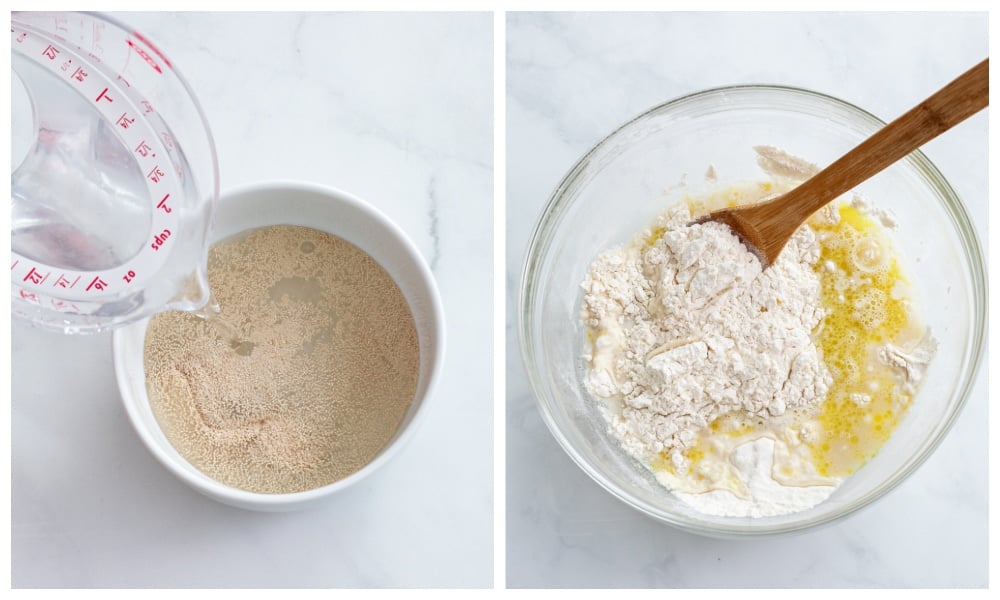 Spray with nonstick cooking spray. Cover with saran wrap and then with a dish towel and place in a warm place to rise for 2-3 hours, until at least doubled in size.
Spray with nonstick cooking spray. Cover with saran wrap and then with a dish towel and place in a warm place to rise for 2-3 hours, until at least doubled in size.
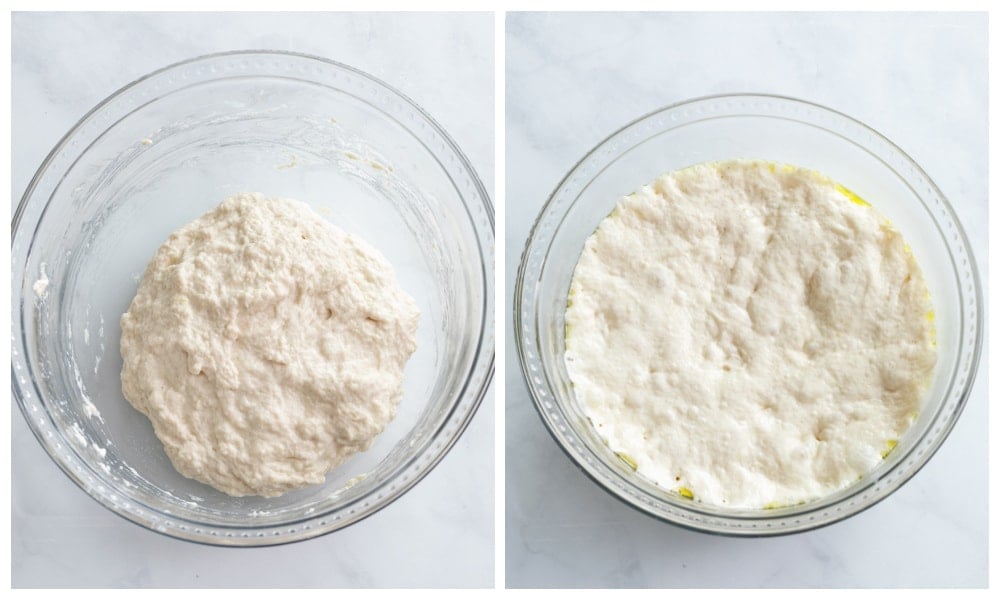
Tilt the bowl and use a silicone spatula to gently slide the dough onto floured parchment paper (or a floured baking sheet if not using Dutch oven.) Fold the dough onto itself to form a ball. Spray with nonstick cooking spray and cover loosely with saran wrap while you preheat the oven and allow the dough to rest/rise for 45 minutes. Place the Dutch oven into the oven while it pre-heats, if using.
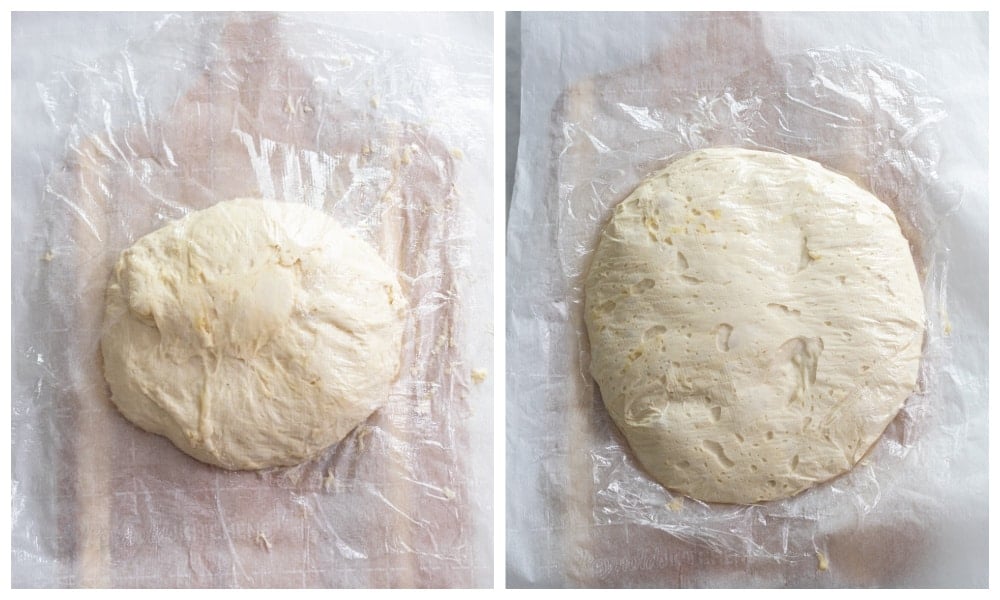
Remove saran wrap from the dough. Lift the parchment paper and carefully transfer the dough into the preheated Dutch oven. Cover and bake at 425 °F for 40 minutes. Remove cover and brush with butter. Bake for 10-12 more minutes, until browned.
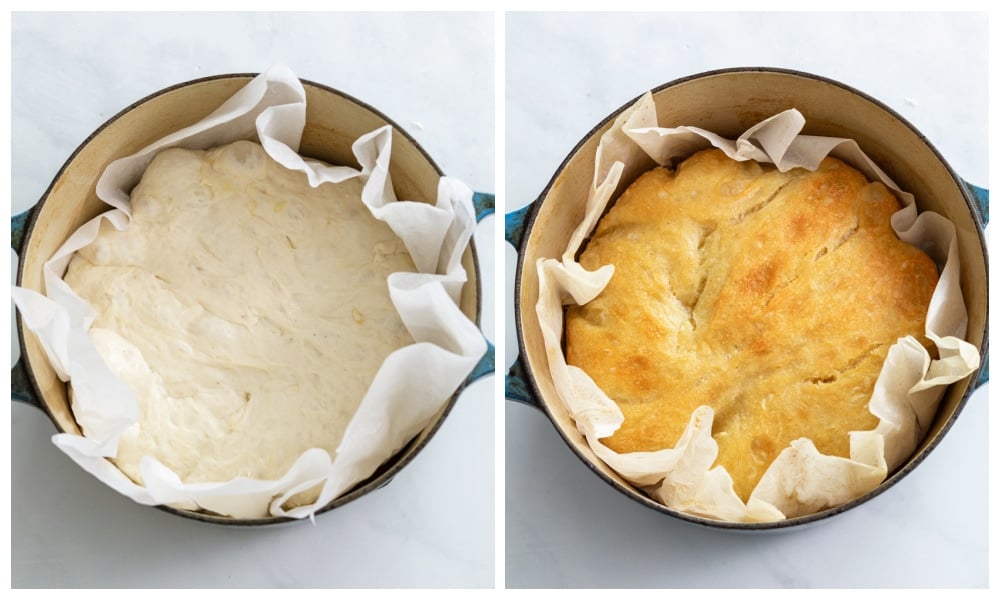
If not using a Dutch oven, remove saran wrap and place the baking sheet in the preheated oven. Bake at 475° for 25 minutes. Brush with butter and bake for 5 more minutes, or until golden brown.
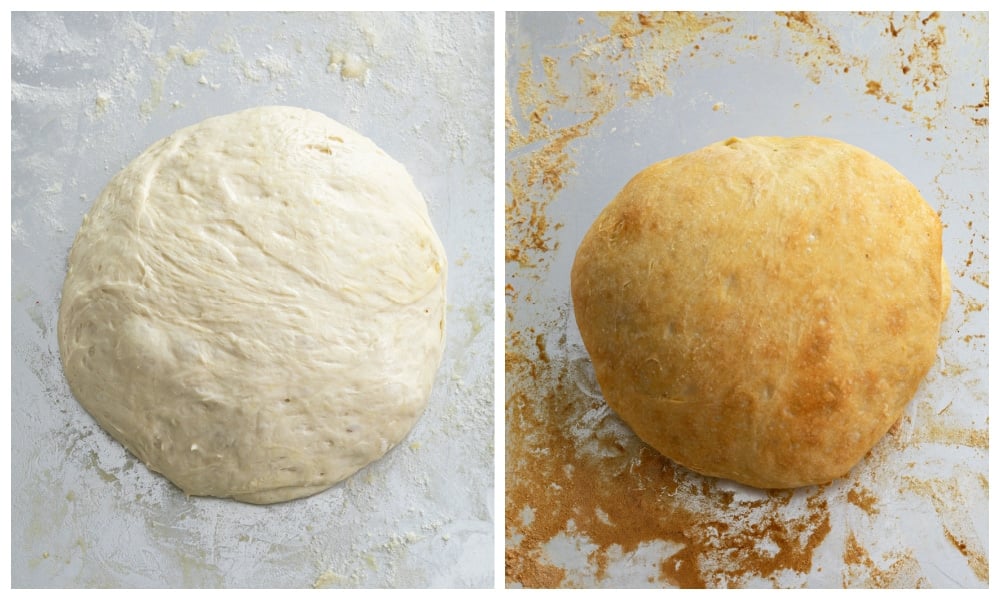
If Your Dough Isn’t Rising
A warm, moist environment is needed for dough to activate and rise. If you need a little boost of warm air, try these tricks:
- Oven: This trick works great! Heat your oven to 200° for 2 minutes, then shut the heat off. Cover the bowl of dough with a dish towel (no plastic wrap in the oven), and shut the door to trap the warm air inside. Let it rise!
- Microwave: Fill a glass measuring cup with 1 cup of water and microwave for 2 minutes, until boiling. Remove the water and replace it with your covered bowl of dough. Close the door right away. The residual heat will allow your dough to rise.
- Warm Dish Towel: Place a kitchen towel in the dryer until it’s nice and warm, place it over the saran wrap on top of the bowl and let it hang over the sides. Repeat as needed.
- Outside: If it’s warm outside, place your dough outside to rise! (Even better if it’s a little humid.)
Baking Temperature
- Dutch Oven Method
- Most parchment paper is oven safe to 425°, so if you’re using the Dutch oven method with parchment paper, I recommend baking at that temperature.
- I don’t recommend not using parchment paper, the dough “sizzles” when it hits the Dutch oven without a layer of protection, since the Dutch oven needs to be preheated before baking to ensure a crispy crust.
- Baking Sheet Method
- I recommend baking at 475° so that the dough sets more quickly and holds it’s shape, since there is no vessel to hold it. I also like to place a cast iron skillet on the bottom rack with water in it to create steam, which helps create a crusty outside.
Dutch Oven vs. No Dutch Oven
- I have tested this recipe with and without a Dutch oven. My preferred method is to use a Dutch oven, as it definitely results in a crispier outer crust. (I use a 3.5 quart but varying sizes are okay.) That said, the baking sheet method produces a great end result as well. You can also use a cast iron skillet.
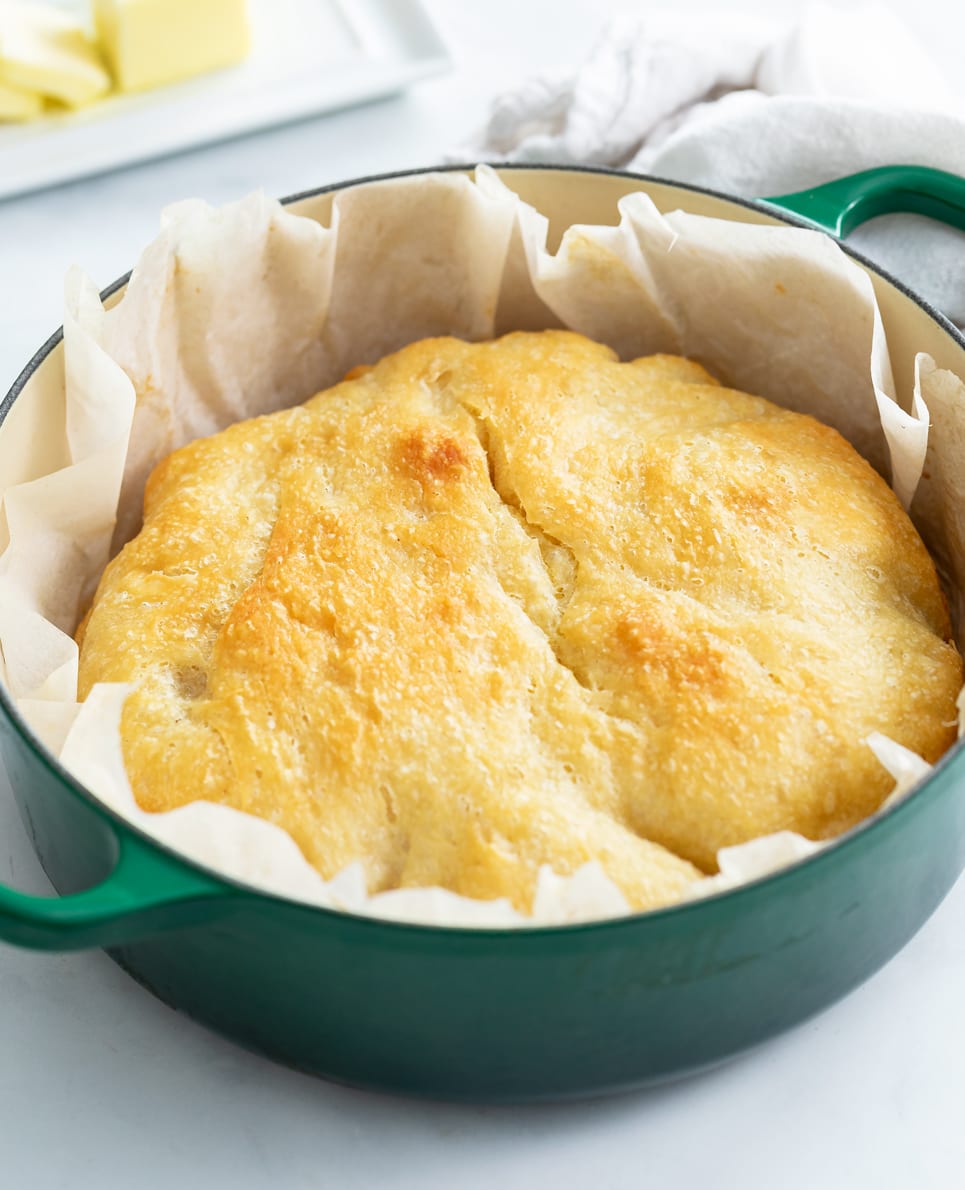
Make Ahead Method
- Let the dough rise once for 2-3 hours as outlined. Transfer the covered dough to the fridge for up to 3 days. This will actually give it more flavor than baking right away.
- Remove from the fridge and proceed with forming it and letting it rest/rise while you preheat the oven for baking.
- Since this dough is super airy and delicate, (unlike pizza dough), I don’t recommend freezing the dough. I would instead freeze the baked bread.
Pro Tips
- My key advice: Handle the dough gently and minimally to keep the airy holes intact. Use a silicone spatula to work with the dough, not your hands. Less is more with the flour. Give the dough sufficient opportunity to rise, (twice).
- Saran wrap traps in moisture and creates a humid environment, perfect for rising. If you don’t have it on hand, place your dough in a greased plastic container with a tight fitting lid to rise in.
- Flour: Be sure to weigh your flour to ensure that you don’t add too much. Bread flour is best in this recipe, but all-purpose can be used if needed. This recipe uses minimal flour, which makes the end result so light and airy. (I’ve used as little as 2 + 3/4 cups before and it’s been great!)
- Yeast: Instant yeast is great for this recipe, but Active and Rapid Rise yeast are fine as well. These photos are actually from using active dry yeast.)
- Salt: Non-iodized salt is best for baking. (Table salt is generally supplemented with iodine, which can generate a bitter taste in baked goods.) I use Redmond Real Salt for all of my baking and cooking recipes. (Enter code ‘COZY‘ for 15% off!) Of course, table salt can be used if that’s what you have on hand.
- Parchment Paper: Crumple it up first so that it better molds to the shape of the Dutch oven, if using that method.
- High Altitudes: Baking at a high altitude typically requires adjustments, see this guide from Bob’s Red Mill on what adjustments may be needed for this recipe.
- Be sure to serve this with my Olive Oil Bread Dip!
- 📘 Find this recipe on page 238 of my 2nd cookbook, Let’s Eat!
Storage
- Store in a covered container at room temperature for 5 days, refrigerate for up to 10 days, or freeze for up to 3 months.
- This bread can be frozen as a whole loaf or in slices. I like to freeze sliced up loaves in a gallon freezer bag, it’s easy to grab for breakfast, lunch, and dinner during the week! Be sure to seal out the air.
- This bread can be sliced lengthwise if being used for sandwiches, or slice it vertically for toast or serving with soups and dips!
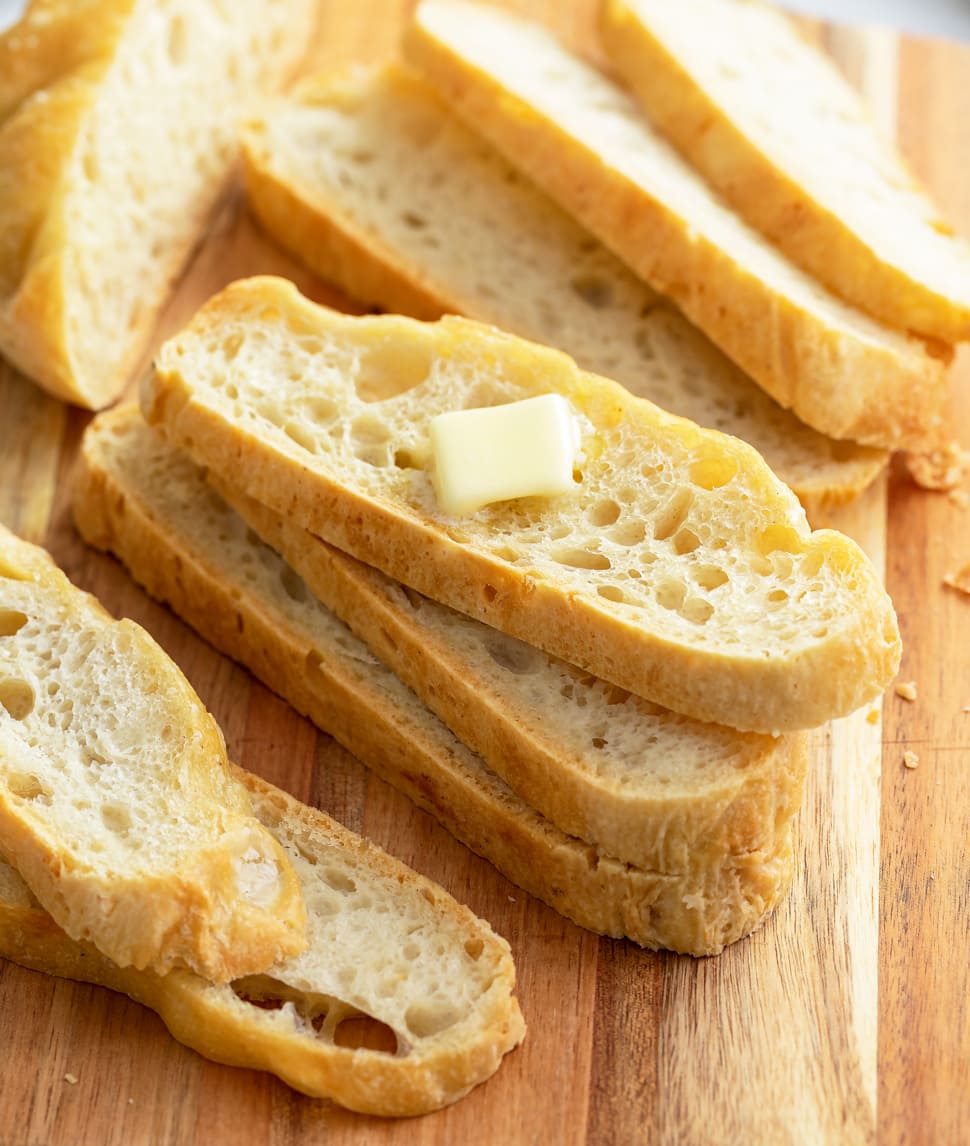
Tools For This Recipe
(Amazon affiliate links)- Check out all of my kitchen essentials here.
- Kitchen Scale– I like to place my mixing bowl on this scale, clear the weight, and then scoop the flour right in. No mess, no muss, no fuss! (Weighing the flour is everything and eliminates any guess work.)
- Mixing Bowls– These 3 sizes are perfect for baking.
- OXO Pop Container– I love storing my flour in here!
- 3.5 Quart Enamel Cast Iron Dutch Oven
- Bread Lame– To easily score the top of your bread if desired.
- Bread Knife & Cutting Board– For nice clean cuts.
What to Serve With No-Knead Bread
See all of my Soup recipes here!
- Broccoli Cheese Soup
- Zuppa Toscana Soup
- BEST Tomato Soup
- Meatball Soup
- Beer Cheese Soup
- Minestrone Soup
Get My Free E-Book!
- I’ve got a FREE e-Book with 7 super popular dinner recipes! Click here to join my email list and I’ll send your e-Book right over!
- And be sure to follow me on Instagram, Pinterest, & Facebook!
Tried This Recipe?
Leave a review, I love hearing your feedback! ⭐⭐⭐⭐⭐
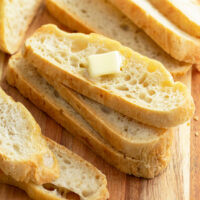
No Knead Bread
Ingredients
- 2 teaspoons instant yeast, active or rapid rise will work as well.
- 2 teaspoons sugar
- 1 ½ cups barely warm water, 100° F
- 3 cups bread flour, 360 grams
- 2 teaspoons salt, see notes
- 1 tablespoon olive oil
- 1 tablespoon butter
Instructions
- See notes for making this without a Dutch oven.
- Note: The dough in this recipe is sticky, gently handle with a silicone spatula throughout this process. (Not your hands.)
- Combine the yeast, sugar, and water in a small bowl. Cover with saran wrap and let sit for 5 minutes.
- Combine the flour and salt and stir to combine. Add the olive oil and water/yeast mixture and use a silicone spatula to combine until all of the flour is moist. The dough will be sticky.
- Roughly shape into a ball and be sure to spray the top with cooking spray. Cover with saran wrap, and then with a dish towel. Let rise for 2-3 hours, until at least doubled in size. See notes for rising tips.
- Optional step after rising: Transfer to the fridge for up to 3 days to develop more flavor. It will rise more, and may eventually deflate slightly, but that’s okay. After refrigerating, proceed with the steps below.
- Use a silicone spatula to scrape the dough out of the bowl and turn it onto a sheet of floured parchment paper. Use a silicone spatula to fold the dough onto itself, by taking the outer edges and folding them into the middle, until a sturdier ball is formed. Spray with nonstick cooking spray, and cover loosely with saran wrap. Let it rest/rise for 45 minutes while you preheat the oven.
- Preheat the oven to 425° F and place the Dutch oven inside, uncovered. (Verify that this is an acceptable practice with your brand of Dutch oven, some advise against preheating it with nothing inside.)
- Remove the saran wrap from the dough. Using oven mitts, remove the Dutch oven from the oven. Lift the parchment paper and carefully lower the parchment paper and dough into the Dutch oven. Close the lid right away and transfer it to the oven.
- Bake for 40 minutes. Remove it from the oven and use a pastry brush to distribute 1 tablespoon of butter over the top, until melted. This will help it achieve a golden-brown color.
- Return it to the oven, uncovered, and bake for 10-12 minutes, or until golden brown on top.
- Allow the bread to cool for at least 5 minutes before slicing in. Serve with Olive Oil Bread Dip!
Notes
- Follow the recipe as outlined through step 5.
- Use a silicone spatula to scrape the dough out of the bowl and turn it onto a lightly floured nonstick baking sheet or cast-iron skillet.
- Use the spatula to fold the dough onto itself by taking the outer edges and folding them into the middle, until a sturdier ball is formed. Spray with nonstick cooking spray and cover loosely with saran wrap. Let it rise for 45 minutes. Gently reshape the ball with the spatula if it becomes too flat after rising.
- Bake at 475° F (not 425° as outlined for Dutch oven method), for 25 minutes, or until the top begins to brown. Remove from the oven and brush with butter. Bake for another 5 minutes, or until the top is lightly golden brown.
- Pro Tip: Place 1.5 cups of water in a shallow pan or cast iron skillet on the bottom oven rack when you preheat the oven for baking. Leave it there while the bread bakes. This will create steam, resulting in a crispier outer crust. (This is to replicate the steam that is created when baked in a covered Dutch oven.)
If Your Dough Isn't Rising: If you need a little boost of warm air, try these tricks:
- Oven: This trick works great! While your yeast is sitting in the warm water, heat your oven to 200° for 2 minutes, then shut the heat off. Place your covered bowl of dough in the oven and shut the door to trap the warm air inside. Let it rise!
- Microwave: Fill a glass measuring cup with 1 cup of water and microwave for 2 minutes, until boiling. Remove the water and replace it with your covered bowl of dough. Close the door right away. The residual heat will allow your dough to rise.
- Warm Dish Towel: Place a kitchen towel in the dryer until it's nice and warm, place it over the saran wrap on top of the bowl and let it hang over the sides. Repeat as needed.
- Outside: If it's warm outside, place your dough outside to rise! (Even better if it's a little humid.)
Pro Tips:
- My key advice: Handle the dough gently and minimally to keep the airy holes intact. Use a silicone spatula, not your hands. Less is more with the flour. Give the dough sufficient opportunity to rise, (twice).
- Saran wrap traps in moisture and creates a humid environment, perfect for rising. If you don't have it on hand, place your dough in a greased plastic container with a tight fitting lid to rise in.
- Flour: Be sure to weigh your flour to ensure that you don't add too much. Bread flour is best in this recipe, but all-purpose can be used if needed. This recipe uses minimal flour, which makes the end result so light and airy.
- Yeast: Instant yeast is great for this recipe, but Active and Rapid Rise yeast are fine as well. (Photos are actually from using active yeast.)
- Salt: Non-iodized salt is best for baking. (Table salt is generally supplemented with iodine, which can generate a bitter taste in baked goods.) I use Redmond Real Salt for all of my baking and cooking recipes. (Enter code 'COZY' for 15% off!) Of course, table salt can definitely be used if that's what you have on hand.
- Parchment Paper: Crumple it up first so that it better molds to the shape of the Dutch oven, if using that method.
- High Altitudes: Baking at a high altitude typically requires adjustments, see this guide from Bob's Red Mill on what adjustments may be needed for this recipe.
- See blog post for: Make-ahead method, info on baking temperatures, and my preference of Dutch oven vs. non Dutch oven.
- 📘 Find this recipe on page 238 of my 2nd cookbook, Let’s Eat!
Storage
- Store in a covered container at room temperature for 5 days, refrigerate for up to 10 days, or freeze for up to 3 months.
- This bread can be frozen as a whole loaf or in slices. I like to freeze sliced up loaves in a gallon freezer bag, it's easy to grab for breakfast, lunch, and dinner during the week! Be sure to seal out the air.


 Get my Cookbooks!
Get my Cookbooks! 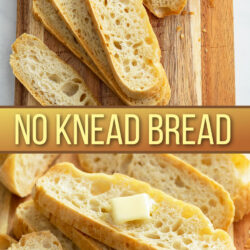
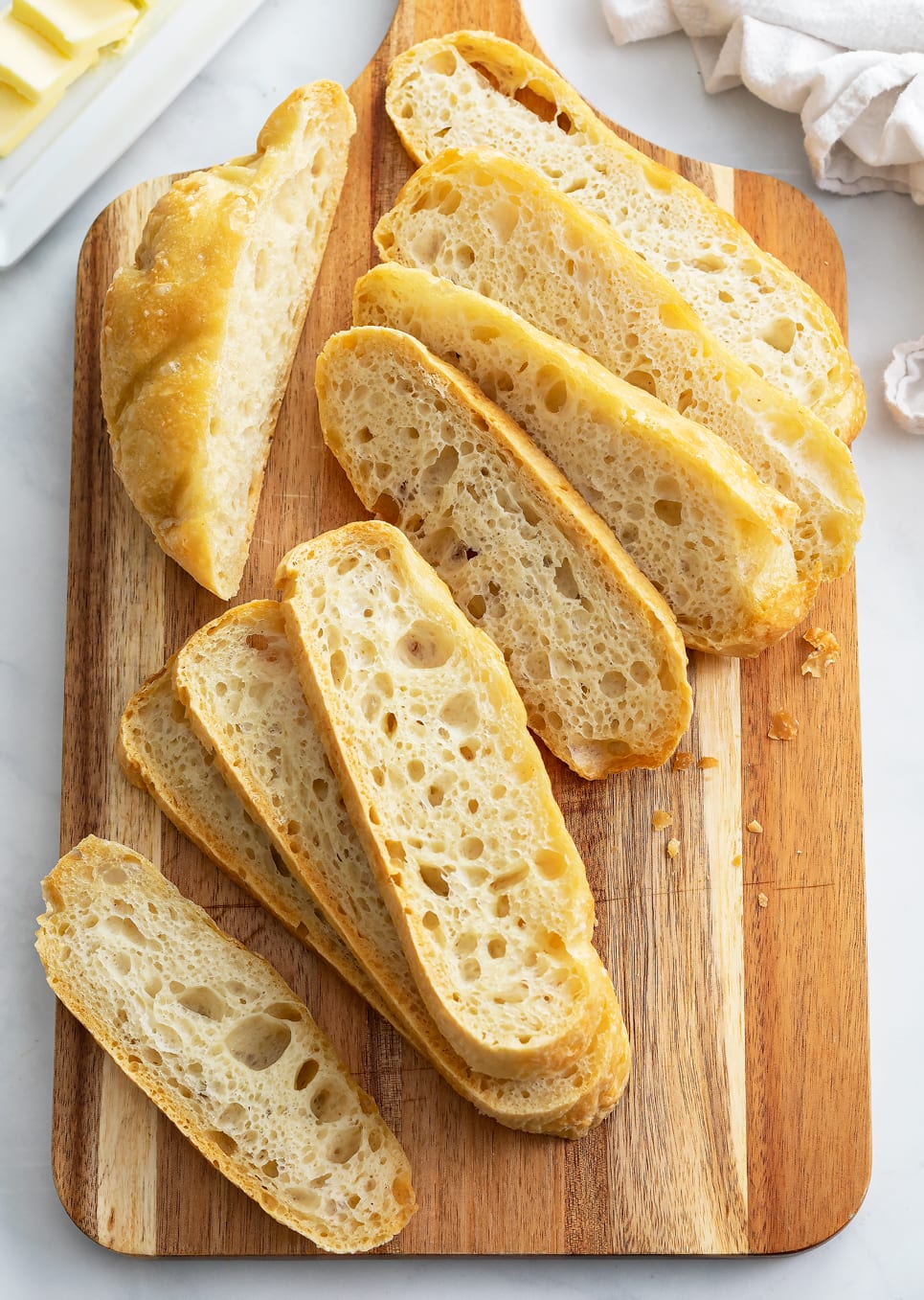











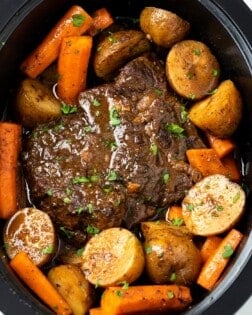

Can you make this bread omitting sugar?
You can! Although it helps activate the yeast and may cause the rise to be a little bit slower, but you can omit it!
First time I’ve ever made bread bc it can be intimidating! Not this recipe! All you do is follow along and it comes out perfectly! Store bought bread will now be a thing of the past!
I am soooo beyond thrilled to hear that Chrissy!! You made my day! Thank you so so much!! ❤️❤️❤️❤️
can i bake this recipe in a pyrex bowl
Hi Laylee, I have tested it various ways as is outlined here, but I haven’t tested it in a Pyrex bowl. It would need to be oven-safe to the temps outlined, and it can shatter if it goes to cool to hot quickly.
I have made this bread several times and it is always a hit. I had to make it ahead of time for an event. I was curious what the best way to warm the bread up without drying it out?
Hey Tami! Here’s what I would do! Preheat oven to 350°F and lightly mist the loaf with a bit of water—just enough to make the crust slightly damp. Wrap loosely in foil (to trap a bit of steam and prevent drying). Bake for 10 to 15 minutes. Enjoy! So glad you love the recipe!
This is such an easy foolproof recipe. I made it all last winter. I’m wondering if anyone has tried it with grated cheese or herbs?
I’m so happy you love it June! Up to 2 teaspoons of dried herbs can be added to the dough right at the beginning, with the flour! You can use any combination of rosemary, basil, oregano, thyme, dill, and more! 🙂 I haven’t added cheese but I’m sure some would be fine! I’d love to know how to goes if you do add some!
Great recipe! Easy and delicious
Excellent! I’m so happy to hear that Erin, thank you so much for the review!! 🙂 -Stephanie
I made this for the second time. It is delicious and it turned out so good inspite of me trying to mess it up several times. It’s a very forgiving recipe. Thank you so much for this recipe
I’m SO happy to hear that Mamie! I totally agree on how forgiving it is, I don’t do a ton of baking but this one never goes wrong! Whew! Thank you so much for taking the time to leave a review, I really appreciate it! 🙂 -Stephanie
Every time I bake this bread my husband says “we never have to buy bread again!” We love it with everything: soups, stews, sandwiches and snacks (with a little bit of honey). A loaf never lasts long. Thank you for the wonderful recipe
Excellent!! I’m soo happy to hear that Wendy, you made my day, thank you so much for taking the time to leave a review! You’re the BEST! 🙂 ❤️ -Stephanie
I’m a huge fan of your Texas Roadhouse Rolls & now this one!! So easy! I baked it in a cast iron Dutch oven with perfect results. Wonderful with a steaming bowl of Chicken Gnocchi soup👍
I’m so happy you’re enjoying the recipes Bonnie!! You just made me want Chicken Gnocchi Soup lol. Thanks so much for the great review!!
Made this bread so many times! Easy and comes out delicious. If you can let the sit dough sit for a day or two it comes out so good.
I’m so happy you’re enjoying it Matthew!! Thanks so much for taking the time to leave a review!😃